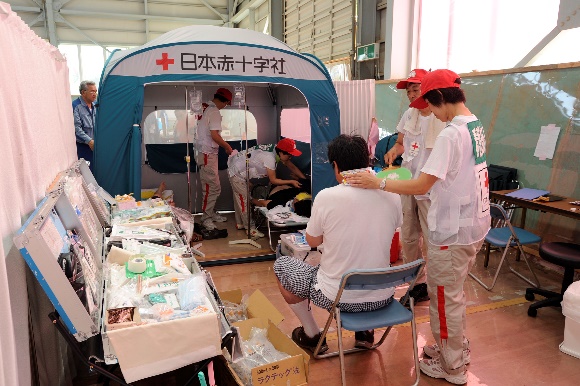The way how the donations from all over the world have been used
1. JRCS Relief and Recovery Programmes utilizing overseas donations mainly from the Red Cross and Red Crescent National Societies around the world

Activities of Relief teams as a temporary entering into the restricted area in Soma, Fukushima in July 2011. (c) JRCS
Immediately after the disaster, the JRCS started the relief and recovery programmes in the fields of rebuilding livelihoods, education, medical services and social welfare services by utilizing overseas donations. The overseas donations are funds entrusted to the JRCS by donors worldwide. As such, these funds must be carefully used for the sake of people in the affected areas. The JRCS conducted a needs assessment in the affected areas, planned and decided the direction of its assistance in full consultation with local authorities to prevent duplication of work. Overseas donations are planned to be spent fully by FY 2020.
2. Recovery Project funded by the State of Kuwait

Sanriku Railway’s Minami-Riasu Line was fully restored to service in Iwate, April 2014. Recovery Project supported the cost for reconstructing stations, etc. to establish a "new Sanriku Railway" as a symbol and a detonator for vitalization of the Sanriku Railway. (c) JRCS
The State of Kuwait donated 5 million barrels of crude oil (equivalent to approximately 40 billion yen) to the Japanese government, and the equivalent amount was donated to the JRCS. This donation was allocated to three most badly impacted prefectures, namely, Iwate, Miyagi, and Fukushima, taking the scale of the damage in each prefecture into consideration comprehensively. This donation was used for the activities conducted directly by each prefecture, such as the purchase of trains for the Sanriku Railway, medical student scholarship funds, or support for satellite schools, etc.
3. Budget Allocation of the overseas donations
(1) JRCS Relief and Recovery Programmes
| Programme | Budget |
|---|---|
| 1. Distribution of Emergency Relief Supplies | 459,925,000 |
| 2. Emergency medical services and PSP | 2,987,000 |
| 3. Regional Healthcare Support | 362,0000,000 |
| 4. Assistance for nuclear power plant disaster victims | 2,245,464,000 |
| 5. Rehabilitation of health infrastructure | 12,186,981,000 |
| 6. Improving the living condition of affected people in evacuation centres and temporary housing |
29,996,587,000 |
| 7. Social welfare support | 1,961,486,000 |
| 8. Children’s education support | 3,661,650,000 |
| 9. Community Based Disaster Preparedness | 1,470,326,000 |
| 10. Capacity building of JRC in the area of disaster management | 2,264,864,000 |
| 11. Other Projects | 16,487,000 |
| 12. Project under formulation | 160,247,000 |
| 13. Project management and support | 2,101,349,000 |
| Total | 60,148,353,000 |
(2) Recovery Project funded by the State of Kuwait
| Programme | Budget |
|---|---|
| Recovery Project funded by the State of Kuwait | 40,066,027,000 |
| Total | 40,066,027,000 |
(3) Total budget of the Relief and Recovery Programmes utilizing overseas donations
| Programme | Budget |
|---|---|
| JRCS Relief and Recovery Programmes | 60,148,353,000 |
| Recovery Project funded by the State of Kuwait | 40,066,027,000 |
| Total | 100,214,380,000 |
Figure 5-4 Budget Allocation of Relief and Recovery Programmes















